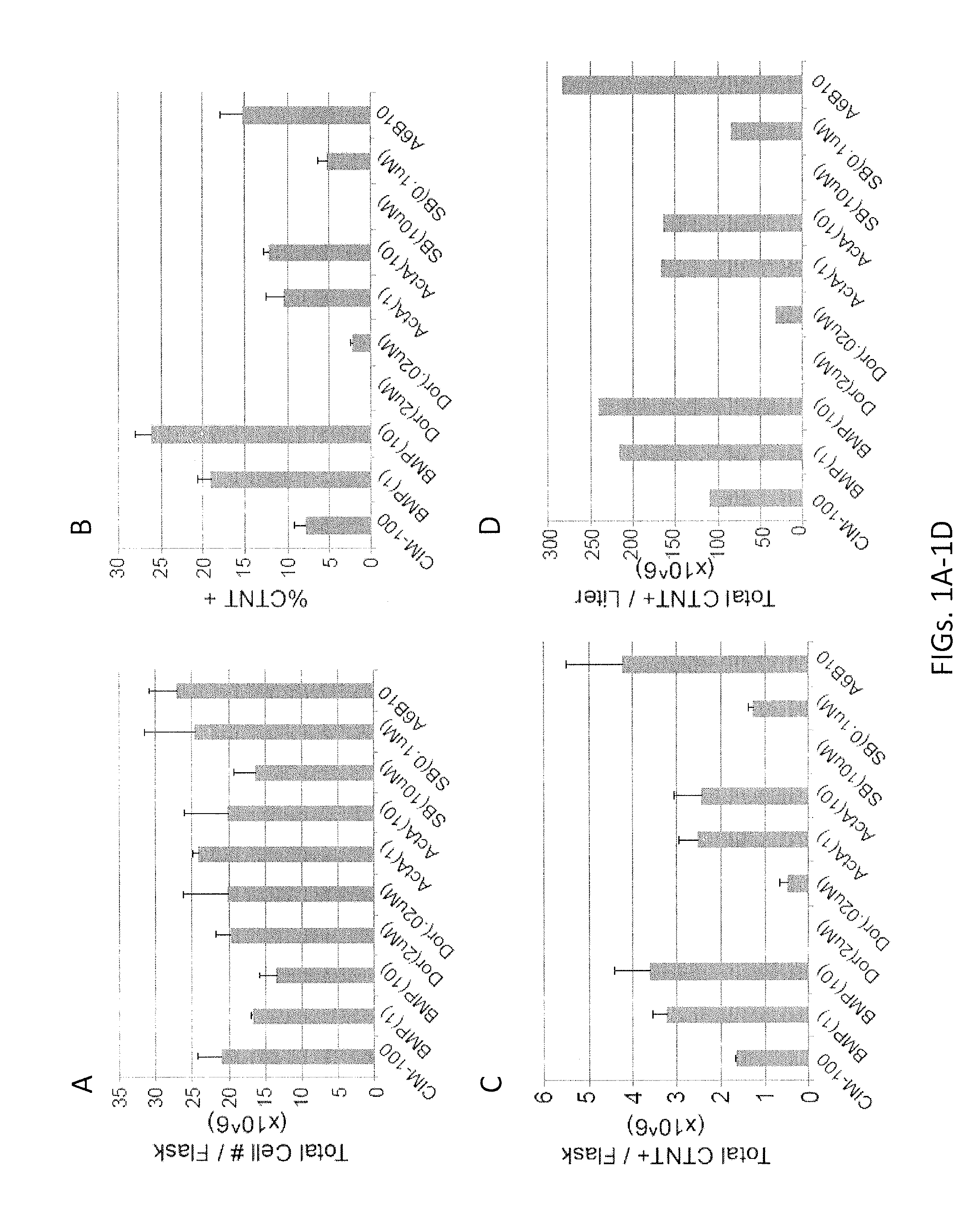Titration of differentiation medium components
a technology of differentiation medium and components, applied in the field of stem cell development, can solve problems such as unpredictability in cell lineage differentiation, and achieve the effect of large-scale production and high efficiency
- Summary
- Abstract
- Description
- Claims
- Application Information
AI Technical Summary
Benefits of technology
Problems solved by technology
Method used
Image
Examples
example 1
Optimizing Cardiomyocyte Differentiation from Different Lines of Pluripotent Stem Cells and after Culture in Different Stem Cell Maintenance Media
[0227]This Example describes a procedure to maximize the differentiation potential of multiple PSC lines or clones, grown in variable primary culture conditions, to the cardiomyocyte lineage by manipulating the salient signaling pathways, including BMP and Activin / Nodal. This procedure includes: 1) screening the cardiogenic potential of each cell line in a number of conditions, followed by 2) customizing the differentiation protocol for an individual PSC line.
[0228]The Manufacturing Procedure as described in U.S. Provisional Application 61 / 252,919 is followed and modified as detailed below.
[0229]At any point during aggregate formation but preferably at day 3 of differentiation, to the typical differentiation culture media (outlined in the Manufacturing Procedure), various combinations of growth factor agonists and antagonists were added. I...
example 2
Neuron Growth Factor Titration Procedure
[0236]iPS cells are maintained on matrigel in TeSR medium (Stem Cell Technologies) and sodium citrate split one passage prior to aggregate formation and grown in T150 flasks, but can be scaled for starting cells in other culture formats. Alternate pluripotent cell culture media, containing varying concentrations of TGFβ and / or bFGF, can be used to optimize neural differentiation of different iPS cell lines or clones. Pluripotent cell cultures are then maintained in TeSR or similar media or can be “primed” or “conditioned” for differentiation for varying lengths of time prior to aggregate formation. Priming of cultures begins 1, 2, or 3 days prior to aggregate formation and may involve adding small molecule inhibitors of the TGFβ or BMP4 pathways to the pluripotent cell culture media, transitioning the cells to DMEM-F12 supplemented with 1×N2, or both strategies in combination. Small molecule inhibitors of TGFβ / Activin / Nodal signaling (SB 43154...
example 3
Hepatocyte Growth Factor Titration Procedure
[0239]iPS cells are maintained on Matrigel in TeSR medium (Stem Cell Technologies) and sodium citrate split. Alternate pluripotent cell culture media, containing varying concentrations of TGFβ and / or bFGF, can be used to optimize hepatocyte differentiation of different iPS cell lines or clones. Pluripotent cell cultures are then maintained in TeSR or similar media or can be “primed” or “conditioned” for differentiation for varying lengths of time prior to aggregate formation. Priming of cultures, if required, begins 1, 2, or 3 days prior to aggregate formation and may involve adding growth factors and / or small molecule inhibitors of TGFβ signalling to the pluripotent cell culture media, transitioning the cells to hepatocyte growth media as described below, or both strategies in combination. As a nonlimiting example, growth factors and small molecule inhibitors of TGFβ signaling can be used in the concentrations detailed below.
[0240]On Day ...
PUM
| Property | Measurement | Unit |
|---|---|---|
| diameter | aaaaa | aaaaa |
| volume | aaaaa | aaaaa |
| volume | aaaaa | aaaaa |
Abstract
Description
Claims
Application Information
 Login to View More
Login to View More - R&D
- Intellectual Property
- Life Sciences
- Materials
- Tech Scout
- Unparalleled Data Quality
- Higher Quality Content
- 60% Fewer Hallucinations
Browse by: Latest US Patents, China's latest patents, Technical Efficacy Thesaurus, Application Domain, Technology Topic, Popular Technical Reports.
© 2025 PatSnap. All rights reserved.Legal|Privacy policy|Modern Slavery Act Transparency Statement|Sitemap|About US| Contact US: help@patsnap.com

